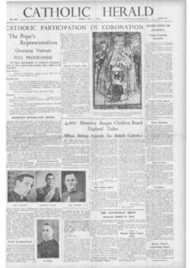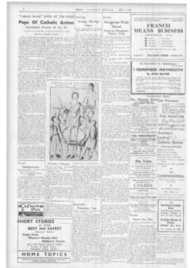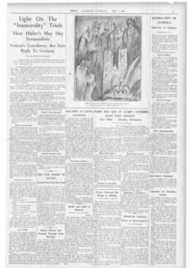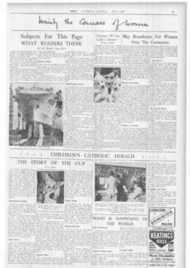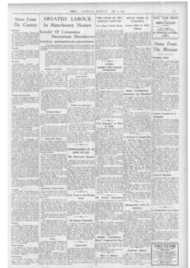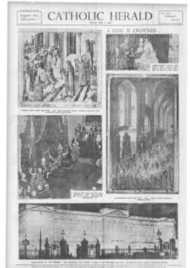Page 12, 7th May 1937
Page 12

Report an error
Noticed an error on this page?If you've noticed an error in this article please click here to report it.
Tags
Share
Related articles
God Save The Queen
Argument Over Coronation
English Saints: Monday Next, October 13, Feast Of St....
In A Drab, Rather Godless World
Easter For Eastern Catholics
CORONATION CEREMONY Not Very Different From The Ancient Catholic Rite
Few Protestant services can claim as great a relic of Britain's Catholic ages as the Coronation ceremony which takes place next Wednesday.
Although English has been substituted for Latin, the Communion service for the Mass and many other transpositions and modifications have been introduced into the prayers, in. substance the Coronation rite used for George VI is still that of Archbishop Egbert of York (732-766). to be At the head of the Egbertine Order is the title " Missa pro regibus in die benedictionis ejus." Then follows an introit, collect, epistle, gradual and gospel, and the rubric, " the blessing upon a newly elected King." The second prayer, " Deus qui populis tuis," in particular, remains quite unchanged. It reads:
" 0 God, who providest for Thy people by Thy power arid rulest over them in love, grant unto this Thy servant George our King, the spirit of wisdom and government, that being devoted unto Thee with all his heart, he may so wisely govern this Kingdom, that in his time Thy Church and people may continue in safety and prosperity, arid that, persevering in good works unto the end, he may through Thy mercy come to Thine everlasting Kingdom, through Jesus Christ Thy Son, our Lord. Amen;'
Following these prayers in the Egbertine
rite comes the anointing of the King. In Catholic times the Unction was the mein pivot of the ceremony and assumed more symbolic importance even than that of the crowning or of the delivery of insignia or enthronement.
" Here all the Bishops, with the maw nates, put the sceptre into his hand," and " Here let all the Bishops take the helmet and set it upon his head," read the early orders, this simultaneous crowning bs several hands being depicted so faithfully te the many contemporary illuminated manuscripts (see page I).
King's Proclamation
After diverse other blessings and prayers have been said, the Mass proceeds and at the conclusion comes the King's first proclamation to his people—the primitive oath;
"/t is rightful conduct in a King newly ordained to make these three behests to his people.
" First that the Church of God and all Christian folk should keep true peace at all times. Amen.
" The second is that he should forbid all robbery and all unrighteous things to all orders. Amen.
" The third is that he should enjoin in all dooms, justice and mercy that the gracious and merciful God of His everlasting mercy, may show pardon to us all. Amen."
Fr. Herbert Thurston has given an explanation of this triple division of the oath. In the surviving English Coronation service, he writes, "before the King three naked swords are carried, two pointed and one without a point, which is hence known as currant?, the sword cut short. The first two swords were known to medieval writers as the sword of ihe\clergy and the sword of justice.
" They represent the King's two promises to defend the Church (not as certain Anglican writers have unwarrantably supposed, to coe.rce and punish the Church). and to punish evil-doers. The third, without a point, most aptly symbolises the mercy with which, as the Sovereign himself is taught to hope for-mercy, all his justice is to be tempered."
Changes in the Rite
The Egbertine rite had many successors. Minor changes were introduced before and after the Norman conquest, when the ring and sword were included for the first time in the insignia.
The most important revision, however, was in the fourteenth century. Known as the Liher kegetits of Abbot Litlyngton, it was used for the first time in the Coronation of Edward II. This font was used throughout the Reformation period and was translated into English for James I.
The Liber Regaiis, is now in the Westminster Library and has thirty-four leaves of vellum with three page illuminations depicting the Coronation of. (a) King. (b) King and Queen, and (c) Queen.
It has been recently rebound in leather, but in its original state, as scribed by Thomas Preston, monk of Westminster, it cost k.'34 19s. 7d.
Last Latin Coronation
The last Latin Coronation was that of Elizabeth, and this version represents the Coronation service at the highest point it attained. It had a coherence and presented a consecutive whole. First introductions consisted of the election by the people and taking of the oath by the Sovereign; then followed the " hallowing " or anointing of the Sovereign, who afterwards, vested in robes, ornaments and crown, was enthroned. The Mass concluded the whole afterwards substituted by the Communion service. In the time of William and Mars came an important alteration in the oath which made it clear that no Cathdlic could become King.
In its present state the oath reads thus.
"ARCHBISHOP: Will you solemnly promise and swear to govern the peoples of Great Britain, Ireland, Canada, Australia. New Zealand and the Union of South Africa, of your possessions and the other Territories to any of them belonging or pertaining and of your Empire of India. according to their respective laws and customs?
" KING: I solemnly promise So to do.
" ARCHBISHOP: Will you to your power cause Law and Justice, in Mercy, to be executed in all your judgments?
" KING: I wilt.
" ARCHBISHOP : Will you to the utmost of your power maintain the Laws of God and the true profession of the Gospel? Will you to the utmost of your power maintain in the United Kingdom the Protestant Reformed Religion established by law? And will you maintain and preserve inviolably the settlement of the Church of England, and the doctrine. worship, discipline and government thereof, as by law established in England? And will you preserve unto the Bishops and Clergy of England, and to the Churches there committed to their charge, all such rights and privileges, as by law do or shall appertain to them, or any of them?
" KING: All this I promise to do.
"Then the King, arising out of his chair, supported as before, and assisted by the Lord Great Chamberlain, the Sword of State being carried before him, shall go to the altar, and there being uncovered, make his solemn oath in the sight of all the people, to observe the premises; laying his right hand upon the Holy Gospel in the Great Bible, saying these words: The things which I have here before promised. I will perform and keep. So help me God.
"Then the King shall kiss the book and sign the oath."
blog comments powered by Disqus


